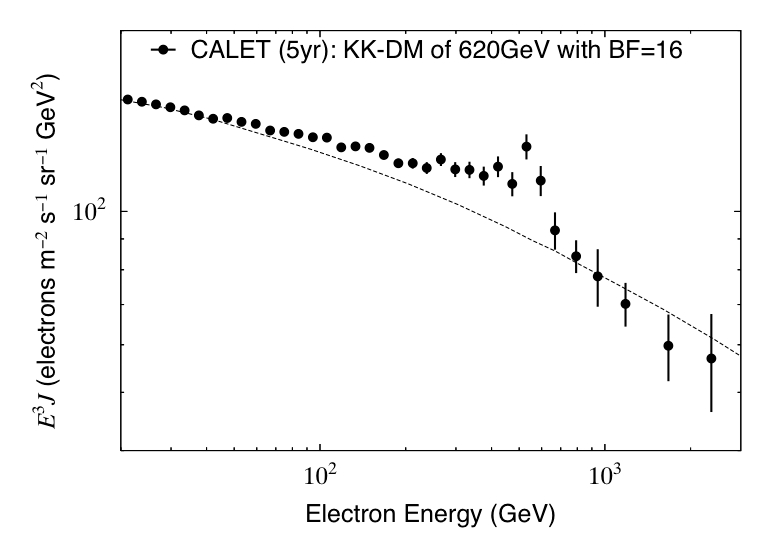“Dark Matter Limits from the CALET Electron+Positron Spectrum with Individual Astrophysical Source Background”, H. Motz et al., Proc. 38th Intl. Cosmic Ray Conf (ICRC 2023): Proc. Science 444, 1385 (2023); https://pos.sissa.it/444/1385/.

Figure 1. The electron spectrum which CALET could measure for case of annihilation of a Kaluza-Klein dark matter population added to the galactic background spectrum (dashed line).
The simplest predicted forms of dark matter are stable and can be observed due to annhilation since these particles are their own anti-particle. Searching for such signatures is one of the main objectives of CALET. Currently, Fermi has seen no firm evidence for a dark matter signature in gamma rays up to ~200 GeV; accelerator experiments have not revealed such a particle at the lower rest mass energies; and direct detection experiments continue to be background limited. The simplest of the theoretical dark matter particles would be expected to favor the gamma-ray channel, while other classes should annihilate into e+e– pairs and p–p pairs. However, the current data from BESS and PAMELA show no evidence for an enhancement in the anti-proton spectrum. Furthermore, most scenarios require large “boost factors” from dark matter density enhancements or other particle physics effects. (Assuming the standard, predicted annihilation cross section and a uniform, or halo concentrated, density distribution of dark matter particles, the annihilation rate is too low to explain the current data. Thus, “boost factors” are introduced to increase the annihilation rate, and there are a variety of proposed mechanism’s to account for such boost factors (BF).
This current situation explains, in part, the intense theoretical interest in the astrophysics data since the rest mass of the dark matter particles may be at the TeV scale where the electron spectrum enhancement is observed. Such TeV-scale physics will remain the provenance of astroparticle physics for many years, thus requiring a true High Energy Observatory, such as CALET.
CALET will tackle the issue of dark matter signatures from two different directions — the e+e– channel and the gamma ray channel. Taking, as an example, the suggested Kaluza-Klein (KK) dark matter candidate with a rest mass of 620 GeV, Figure 1 shows the anticipated results for the electron spectrum with the KK signature superimposed on the standard galactic background spectrum (again, E3 x flux is plotted). The statistical uncertainties reflect a five year exposure and assume a boost factor (BF) of 16. Clearly, this simple annihilation scheme may not correspond to reality, since intermediate mass boson states have been proposed which would spread the electrons into additional peaks, and there are propagation effects which depend upon the distance to the dark matter region. However, Figure 1 demonstrates that CALET, in a five year mission, will have both the statistics and the resolution to investigate the possible structure in detail.

Figure 2. Anticipated gamma ray line for an 820 GeV
neutralino dark matter candidate.
For the gamma ray observations, CALET operates in sky-scanning mode and will record all high energy gamma ray events to study the galactic background and to search for dark matter signatures in the gamma-ray energy spectrum. Fermi has looked at the diffuse emission, in one case from 20-300 GeV and in another latitude band from 0.1-10 GeV, and reported no structure at these low energies. Assuming a SUSY neutralino particle of mass 820 GeV, the possible CALET observation in the gamma ray mode is illustrated in Figure 2. With its excellent energy resolution CALET would observe a “line” at 820 GeV which is only a few energy bins in width. This spectrum requires a BF of only 2 to obtain the indicated precision. Thus, CALET can easily observe (or rule out) such dark matter annihilation channels in the TeV region. Even a non-observation (at a BF=2) would be highly significant for the many theories surrounding dark matter particle physics.